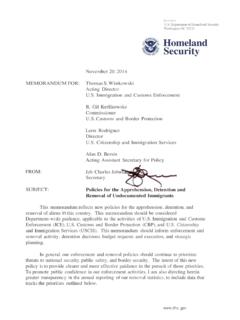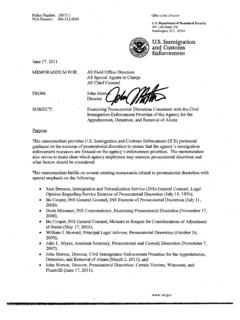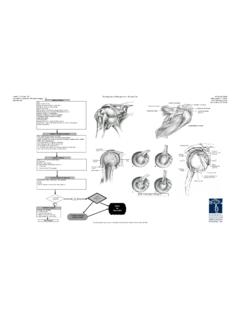Transcription of Lecture 8: Classical Theory, Deterrence Theory, …
1 Lecture 8: Classical theory , Deterrence theory , Rational Choice theory , Routine Activities theory I. Classical theory II. Modern Deterrence theory III. Rational Choice theory IV. Routine Activities theory 1. Part I: Classical Criminology and the Deterrence Doctrine Beccaria believed people want to achieve pleasure and avoid pain. Crime provides some pleasure, thus to deter crime one must administer some pain. Cesare Beccaria, 1738-1794. 2. Jeremy Bentham (1748-1833). British philosopher who helped popularize Beccaria's views. Believed that punishments are harmful, thus these must promise to prevent more evil than they create.
2 3. Beccaria's Desire to End Cruel Punishment 4. Classical Criminology Decisions to violate the law are weighed against possible punishments. To deter crime, the pain of punishment must outweigh the benefit of illegal gain. 5. Assumptions of Human Nature Individuals have free will: Freedom to make personal behavioral choices unencumbered by environmental factors such as poverty or ideological beliefs. Individuals maximize utility ( , happiness, food, resources) by weighing benefits and costs of their future actions before deciding on behavior. 6. Classic Deterrence theory Primary purpose of punishment is Deterrence rather than vengeance.
3 Severity: Punishment must be just severe enough to overcome the gain from a crime. Punishment that is too severe is unjust, and punishment that is not server enough will not deter. Without proportionality, people will not be deterred from committing more serious crimes ( , if rape and murder both punished with death, a rapist would have little reason to refrain from killing the victim). 7. Classic Deterrence : Celerity and Certainty Celerity: swiftness with which criminal sanctions are applied after the commission of crime. Certainty: probability of apprehension and punishment for a crime ( , There is a 1%.)
4 Chance I will get caught, and if so, they would never throw me in jail ). 8. 9. Absolute and Marginal Deterrence Absolute Deterrence : A particular punishment can deter a type of crime completely. Marginal Deterrence : A relatively more severe penalty will produce some reduction in crime. Does the state provide a significant marginal deterrent beyond that assured by informal control systems and socialization? 10. The Purposes of Punishment General Deterrence - By punishing the offender we hope that others considering committing the same crime with not think it worth it Specific Deterrence - Same as above, but with respect to the offender themselves, not other potential offenders Incapacitation - If the offender is in jail.
5 Society is safe Retribution - Offenders deserve punishment as a payment to society for their crimes Moral Outrage - Catharsis and relief for society closure Rehabilitation - May provide an opportunity to help the offender Restitution - Offenders should compensate their victims 11. Part II. Modern Deterrence theory Classical approach important in justice policy during the 19th century, but became of less interest to criminologists at the end of the 19th century. Beginning in the mid-1970s, a resurgence in interest in the Classical approach. Rehabilitation approach came under attack from conservative citizens and politicians.
6 Rational actor models from economics and political science brought to criminology. 12. REBIRTH in the 70's and 80 s Martinson Report and the nothing works . attack on rehabilitation Thinking About Crime by James Q. Wilson attacks view that crime is a function of external forces Wilson proposes a forceful reaction to crime, otherwise, those sitting on the fence will get the idea that crime pays . 13. 3. Deterrence Hypothesis Hypothesis: When the certainty, severity, and celerity of criminal sanctions are high in a population, criminal behavior will be low. 14. 15. Objective Measures Independent Variables: Certainty or risk of penalty: measured by arrest rate (total arrests/total crimes) or proportion of arrested individuals prosecuted.
7 Severity: maximum sentence provided by law ( capital punishment), proportion of convicted offenders sentenced to prison. Dependent Variable: Official crime rate known to police. 16. Empirical Evidence: Capital Punishment and Homicide Immediate Impact Studies: If capital punishment is effective, it should have greatest impact after a well publicized execution. Comparative Research: Compare areas (counties, states, countries) with respect to capital punishment laws and homicide rates. Time Series Analysis: Compare homicide rates and death penalty statutes through time.
8 17. Immediate Impact Studies: Brutalization Effect: Does Death Penalty Cause MORE homicides? More homicides have been found ten days after a publicized execution in California (+ .25 per execution ). and in Philadelphia (+. per execution). Greater Annual Increase in California Homicide Rates for 18. Years WITH executions. Comparative Research 19. Comparative Research The 5 countries with the highest homicide rates that do not impose the death penalty average murders per every 100,000. people, The 5 countries with the highest homicide rate that do impose the death penalty average murders every 100,000 people.
9 20. 21. Problem with Ehrlich's Analysis Ehrlich's findings in support of the Deterrence hypothesis vanished when certain years ( , 1960s) are excluded. Problem with measuring certainty in his model. Police undercounted reported crime, and possibly over counted arrests, thus certainty of apprehension variable was biased in Ehrlich's model. 22. What do 67 leading criminologists believe about Deterrence and capital punishment? Over 80 % of these experts believe the existing research fails to support a Deterrence justification for capital punishment. Over 75% believe that increasing the frequency of executions, or decreasing the time spent on death row before execution, would not produce a general deterrent effects.
10 23. What do the police think? 67% percent of all law enforcement officers do not feel capital punishment decreases the rate of homicides. 82% of the nations law enforcement officials believe that criminals do not think about possible punishments when they commit a crime. 24. Are Criminal Sanctions More Effective Deterrents for other Types of Crimes Cable TV wire splitters. Drinking and driving. Dispute-related violence (domestic violence, honor , passion ). 25. 26. Perceptual Measures Perception of criminal sanctions important. Measures an individual's perception about the risks of being apprehended and punished for a crime, and their likelihood to commit a crime.








